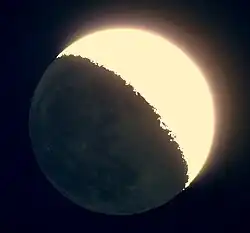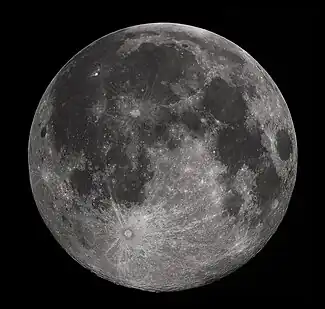


Earthlight is the diffuse reflection of sunlight reflected from Earth's surface and clouds. Earthshine (an example of planetshine), also known as the Moon's ashen glow, is the dim illumination of the otherwise unilluminated portion of the Moon by this indirect sunlight. Earthlight on the Moon during the waxing crescent is called "the old Moon in the new Moon's arms",[1] while that during the waning crescent is called "the new Moon in the old Moon's arms".[2]
Visibility
Earthlight has a calculated maximum apparent magnitude of −17.7 as viewed from the Moon.[3] When the Earth is at maximum phase, the total radiance at the lunar surface is approximately 0.15 W m−2 from Earthlight. This is only 0.01% of the radiance from direct Sunlight.[4] Earthshine has a calculated maximum apparent magnitude of −3.69 as viewed from Earth.[3]
This phenomenon is most visible from Earth at night (or astronomical twilight) a few days before or after the day of new moon,[5] when the lunar phase is a thin crescent. On these nights, the entire lunar disk is both directly and indirectly sunlit, and is thus unevenly bright enough to see. Earthshine is most clearly seen after dusk during the waxing crescent (in the western sky) and before dawn during the waning crescent (in the eastern sky).
The term earthlight would also be suitable for an observer on the Moon seeing Earth during the lunar night, or for an astronaut inside a spacecraft looking out the window.[6] Arthur C. Clarke uses it in this sense in his 1955 novel Earthlight.
High contrast photography is also able to reveal the night side of the moon illuminated by Earthlight during a solar eclipse.[7]
Radio frequency transmissions are also reflected by the moon; for example, see Earth–Moon–Earth communication.
History
The phenomenon was sketched[8] and remarked upon in the 16th century by Leonardo da Vinci, who thought that the illumination came from reflections from the Earth's oceans (we now know that clouds account for much more reflected intensity than the oceans).[9]
It is referenced in "The Ballad of Sir Patrick Spens" (Child Ballad No. 58), in the phrase "‘A saw the new muin late yestreen/ Wi the auld muin in her airm."[10]
See also
References
- ↑ Nemiroff, Robert; Bonnell, Jerry (20 January 2018). "Old Moon in the New Moon's Arms". Astronomy Picture of the Day. NASA. Archived from the original on 17 June 2019. Retrieved 11 January 2020.
- ↑ Nemiroff, Robert; Bonnell, Jerry (24 March 2012). "The New Moon in the Old Moon's Arms". Astronomy Picture of the Day. NASA. Archived from the original on 3 September 2019. Retrieved 11 January 2020.
- 1 2 Agrawal, Dulli Chandra (2016-03-30). "Apparent magnitude of earthshine: a simple calculation". European Journal of Physics. IOP Publishing. 37 (3): 035601. Bibcode:2016EJPh...37c5601A. doi:10.1088/0143-0807/37/3/035601. ISSN 0143-0807. S2CID 124231299.
- ↑ Glenar, David A.; et al. (March 2019). "Earthshine as an illumination source at the Moon". Icarus. 321: 841–856. arXiv:1904.00236. Bibcode:2019Icar..321..841G. doi:10.1016/j.icarus.2018.12.025. S2CID 90262609.
- ↑ The Eclectic Magazine of Foreign Literature, Science, and Art. Leavitt, Trow, & Company. 1874.
- ↑ Nemiroff, Robert; Bonnell, Jerry (19 April 2002). "The Old Moon in the New Moon's Arms". Astronomy Picture of the Day. NASA. Archived from the original on 3 September 2019. Retrieved 11 January 2020.
- ↑ Claro, Michael (October 2, 2019). "Earthshine's Faint Illumination of the Moon Captured in Glorious Eclipse Photo," Space.com. Retrieved 18 May 2023.
- ↑ da Vinci, Leonardo, "Moon by earthlight, Science Photo Library. Retrieved 18 May 2023.
- ↑ Carter, Jamie (May 15, 2023). "How to see ghostly 'Da Vinci glow' illuminate the crescent moon this week, Live Science. Retrieved 18 May 2023.
- ↑ Scottish anonymous (18th century or earlier; date uncertain). "Sir Patrick Spens," Scottish Poetry library. Retrieved 18 May 2023.
External links
 Media related to Earthshine at Wikimedia Commons
Media related to Earthshine at Wikimedia Commons
